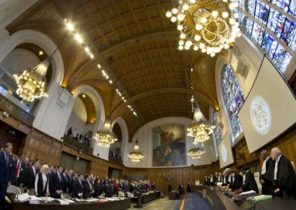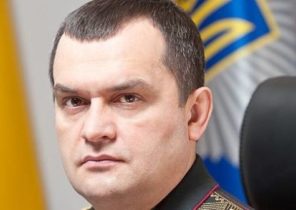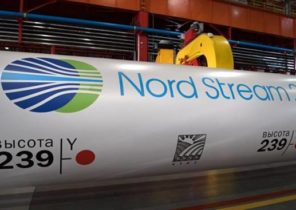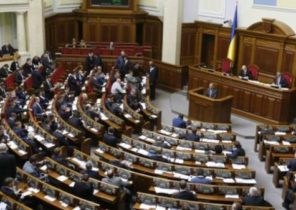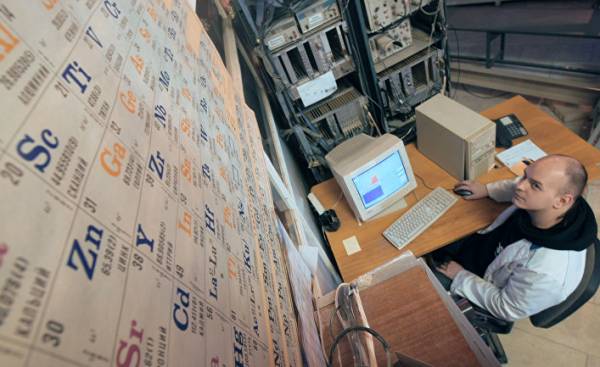
In the Congress center of Dubna (Volga small town with a population of 70 000 people in 120 kilometers from Moscow) is held a Banquet on the occasion of the sixtieth anniversary of the Laboratory of nuclear reactions to them.Flerov. Plenty of alcohol around, and the murmur of conversation quickly becomes louder. Soon to follow their progress becomes increasingly difficult. But we are not too sorry about that: so it is clear that little we understand. Darmstadt, rentgeny, copernici, Dubna… For a mere mortal words of physicists and chemists don’t mean anything.
For one simple reason: we are talking about the elements, which in principle does not exist on our planet. More specifically, they were produced artificially in particle accelerators and have the same nature as encountered in a significant number of hydrogen, helium, chromium, lead, gold or uranium. At the same time, they are much harder… “Superheavy” elements, as they say here.
Fortunately, the body language easily allows you to fill in the gaps of vocabulary. Soon it becomes clear that the good mood of others is not due to a selection of snacks and not happy about the meeting of specialists from different countries. It reflects a General sense of satisfaction, which, after libations looms as a revenge for decades of trouble and frustration…
The fact that the year 2017 was a year of victories in a closed, but an incredibly prestigious and competitive discipline called physics of superheavy elements. So, on March 2 at the meeting in Moscow, the touching ceremony of the international Union of pure and applied chemistry (IUPAC, the only authority with the powers for such a procedure) officially completed the “inauguration” of four new chemical elements, thereby officially confirming their existence in the real world. And not just any kind. In conjunction with the approved in 2012 the two predecessors they may be, will allow physicists to finally solve the old problem General properties of simple substances.
An impressive achievement. Traditionally, the chemical elements are classified in order of increasing number of protons in the nuclei of their atoms around which electrons revolve. Thus, the hydrogen atom which contains only one proton occupies the first position. Helium with its two protons appears at number 2. Lithium is the third, etc. In turn the last of the four open element received rooms 113, 115, 117 and 118.
The first three were named “nyoni” (Nh), “Muscovy” (Mc) and “Tennessean” (Ts), respectively, in the honor of the country (Japan), Russian region (Moscow oblast) and the us state (Tennessee) where there are scientific centers, which play a key role in their synthesis and identification: Institute of physical and chemical research, joint Institute for nuclear research (JINR, it includes a Laboratory them.Flerov) and the national laboratory of oak ridge. As for the fourth and most difficult of all (118 protons), it was called “ohanneson” (Og) in honor of Professor Yuri Oganessian, who at 84 remains in good health and a clear mind, and now toast at the table of honored guests.
State propaganda
A few hours earlier, while the audience in the concert hall the guests enjoyed the excerpts from the operas of Handel and Bizet, the elderly Russian physicist (his influence in his team still is huge) alone walked through the corridors of the House of culture and peace, taking advantage of the lull to consider the pictures. One of them he is depicted as a young Moscow student (he hails from an Armenian family from Rostov-on-don), which first arrived in Dubna in 1957.
In those days the fear of the destructive power of the atom (it had strengthened the memories of the bombing of Hiroshima and Nagasaki) were mixed in the minds of scientists hope to tame this new source of energy to use it for peaceful purposes. At JINR (this international research facility was founded in 1956, the Soviet Union to compete with the European organization for nuclear research) aims to create an open to the world outside the lab to explore the potential of the heavy elements.
Uranium, the heaviest of all existing in the world of 92 elements found in natural form, however, this does not apply to plutonium (goes to table number 94), which is used by the military to create bombs. It is almost entirely artificial and produced by the reactors. The idea of the physicist Georgi Flerov (1913-1990) was the fact that when moving towards more heavy atoms we can stumble upon a rare gem from the point of view of energy production. The elements are numbered from 93 to 101 was almost entirely opened in the period from 1940 to 1955, a team of American Glenn Seaborg (Glenn Seaborg, 1912-1999) of the National laboratory. Lawrence Berkeley studies in the framework of the Manhattan project or on the basis of samples from the explosion of “Ivy Mike” (the first in the history of the hydrogen bomb).
Work, which from a distance looked, the military, focused on items with a serial number more than 102. In a short time thanks to the famous cyclotron U-300 of Soviet scientists (but not only them) also managed to create new chemical elements. From 1963 to 1974 in Dubna was received the items numbered 102, 104, 103, 105 and 106.
Anyway, during the cold war, these both prestigious and radical research (unless their goal was not to define the limits of nature?) was put at the service of state propaganda. Therefore, since 1960-ies of the USSR, USA and Germany (Institute of heavy ions in Darmstadt) began to challenge each other’s superiority in the opening elements and the right to give them names. As a result, the elements numbered 104 and 105 for a long time was called differently on both sides of the iron curtain: rutherfordi and Hani in the West, kurchatove and Dillsboro in the East.
These “transfermate war,” as they are called subsequently (due to the fact that the elements were in the periodic table above fermium, 100), touched eight atoms. All the issues were finally resolved IUPAC after many disputes… only in 1997!
To reach the limit
This conflict is typical for its era, which was characterized by the rivalry of the great powers in all fields, from the space race to travel the depths of the ocean. For the most part, it is due to unscrupulous behaviour with a considerable share of chauvinism. In addition, exacerbated the situation, probably, and incorrect assessment. The fact that from the very beginning, physicists were convinced that the creation of all heavier elements will eventually lead them to the limit beyond which the synthesis is simply impossible.
In nature all is so that all elements that have more mass than lead (82) are radioactive. This means that over time they self-destruct and form lighter nuclei, releasing in the case of gamma or alpha radiation, electrons, neutrons and protons. First observations pointed to the fact that the rate of this process increases with mass of the element. If the half-life of uranium (in its nucleus has 92 protons) is 4.5 billion years, the plutonium (94 protons), it is 80 million years. Takes 98 place California there are only about 900 years!
The scientists saw no reason why this trend stopped in the future. And isn’t that predicted in 1939 by Danish and American physicists Niels Bohr (Niels Bohr) and John Wheeler (John Wheeler) in the famous article about nuclear decay? Who was willing to challenge their view of the nucleus of an atom as “drops” in which neutrons and protons are scattered uniformly? Does not indicate whether this model is that above 100 rooms in the table of elements can not exist? The arguments seemed infallible.
However, as says Yuri Oganessian (office next to his own now a Museum of his mentor Georgi Flerov), from 1960-ies started to conduct various experiments (including in Dubna) that questioned the representation of the nucleus of an atom as a homogeneous formation: “it Seemed increasingly obvious that it must be an internal structure.”
Magic numbers
Soon theorists have put forward a new assumption that inside the nucleus protons and neutrons form the “layers” about the same as the electrons in the atoms. In 1966 they came to the amazing conclusion that physicists laid the path actually continues and gets to the regions where the atoms become stable again. More specifically, the calculations showed that the nucleus whose number of protons and neutrons close to the “magic” 114 and 184 (different outstanding stability) should have a long half-life. According to the first estimates, it had to go on millions or even billions of years. Moreover, they could even be non-radioactive. In other words, put forward the idea of the possibility of the synthesis of new simple substances, which are comparable in lifetime to those that make up our earthly environment. Crazy alchemist’s dream!
Subsequently, the experts have repeatedly confirmed this hypothesis. But the subsequent history is reduced to a long search for Eldorado nuclear physics: the “island of stability”. But how to achieve it? To create enough heavy elements like 114 at the time seemed a daunting task. In theory, of course, was simple: need to collect one nucleus protons and neutrons of two less massive atoms. Was known and the procedure required to disperse some atoms (with the help of the powerful electromagnetic field of a cyclotron or other installation) to velocities of the order of one tenth the speed of light, and then direct them to a hard goal of 100 billion per second.
At successful coincidence of circumstances from time to time there is a collision of atoms. Sometimes it leads to a “fusion” of the nuclei, creating a new element in the so-called phase of “neutron cooling”. All details in this game of bowling was limited to the careful selection of “tools”. The fact that not all of them fit for use and was available: some are hard to get, others are very expensive, others created problems in terms of security. Some combinations (the subject of fierce competition of teams of specialists) were more successful than others. As a result, in those days, “ingredients” was selected in such a way that the synthesis of elements with a number greater than 106 was the crane is unlikely.
Here business was entered by Yuri Hovhannisyan. The chief engineer of the Dubna center developed a technique so-called “cold fusion” which was quickly copied abroad, at first to no avail, but then after long research in Germany, with great success. Thanks to the Institute of heavy ions in Darmstadt opened with 1981 1994 all chemical elements under the numbers from 107 to 112. Japanese experts, in turn, synthesized in 2012 113 item.
However, in the 1990-ies became apparent drawbacks of this method. The fact that the heavy nuclei it is possible to obtain only in trace amounts. And it has become a real problem. To confirm the existence nixonia (113) Japanese physicists had to settle for just three atoms. Moreover, their synthesis took ten years: two were received in 2005 and the third in 2012!
So physics Laboratory. Flerov (Yuri Hovhannisyan headed it in 1989) decided once again to change the “target” and “shells” using the isotopes of elements that have a large number of neutrons. For the synthesis of element 114 they decided to use exotic plutonium-244 and calcium-48, a rare form of natural calcium with a market value of $ 200,000 per gram. Anyway, to test this combination they had to conduct a major modification of installations of U-400 and U-400M, which still worked in Dubna. To realize this was very difficult in the transition period in Russia after the collapse of the Soviet Union: the country experienced a severe financial and economic crisis. As a result, the team was able to confirm the correctness of calculations only in 1998 and 2000, when she was open to the elements with numbers 114 and 116 (officially named “planovi” (Fl) and “Livermore” (Lv) in 2012).
The following rooms, the latter at the moment, cost the science that is expensive. In the United States broke the scandal: Victor Ninova, of the National laboratory. Lawrence Berkeley, who declared in 1999 on the synthesis of element 118, was accused of falsifying data by presenting the evidence. In the narrow circle of Western experts in this field, swept a long and deep crisis, and the Dubna laboratory (Yuri Oganessian, meanwhile, managed to establish cooperation with Lawrence Livermore national laboratory and the National laboratory of oak ridge) was left without direct competitors. Team Hovhannisyan took advantage of the opportunity and synthesized in their impressive installations (occupy two buildings) three important elements: ohanneson, Muscovy and Tennessean.
Reliable model
The creation of 118, 115, and 117 elements, as well as nixonia (113) was the completion which started on the eve of the Second world war long cycle. For nearly 80 years physicists have managed to add 26 simple substances to known to the fact 92, completing the periodic table up to the last seventh period. The half-life and radioactivity of 300 of their isotopes were also measured, which allowed “to create a reliable model of the nucleus of the atom with an accuracy of up to 5%,” — said Yuri Hovhannisyan.
Anyway, a physicist has still not managed to reach the centre of the “island of stability”, the mythical Flerova atom with 114 protons and 184 neutrons. At the moment, the heaviest of the resulting isotopes of this element, their number was 175. At the same time in “the map of nuclei” of the investigated area now form a circle around a terra incognita, which they say features such as, for example, longer lifetime (up to several seconds). Physicists believe that the half-lives of such nuclei actually shorter than originally thought (probably less than 30 years). According to various theories, everything is at 120 or 126 of the element, whereas some do not exclude the possibility of the existence of stable nuclei somewhere between 108 and 112. If this zone actually has similar qualities and located in the same place, sooner or later it has been made. However, as noted by Yuri Hovhannisyan, “it will happen because by that time we will better understand the superheavy elements”.
The fact that they still have almost all my secrets. But how could it be otherwise? With the current capabilities of the expense of the synthesized atoms is unity. Oganesova they were created just four. Therefore, in the Laboratory. Flerova has set itself a new goal: it is a project of the factory of superheavy elements cost about $ 60 billion, for which they must be synthesized up to 100 times faster than currently possible, for further study. These experiences will help physicists to test the untestable in the present theory, like the assumption of Yuri Hovhannisyan about the existence of a second “island of stability”. He might be somewhere very far from Oganesova, in the higher spheres of the elements, where for 60 years the aspiring thoughts of the Russian physicist…

